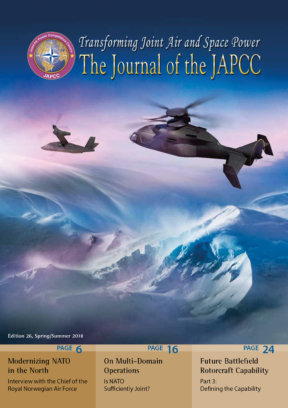Introduction
Researchers have been studying the possibility of refuelling aircraft without a human at the controls for nearly two decades. Finally, that research is coming to fruition. In 2007, an Automated Aerial Refuelling Demonstration (AARD) achieved a major milestone by conducting the first automated (piloted but ‘hands off’) engagement of a probe and drogue system.
That test was led by the US National Aeronautics and Space Administration (NASA), the Defence Advanced Research Projects Administration (DARPA), and their industry partners. Since then research and development efforts have continued via the US Air Force Research Laboratory’s (AFRL) Automated Air-to-Air Refuelling (A3R) program and the NAVAIR X-47B A3R demonstration which culminated in the world’s first contact between an automated unmanned aircraft and a manned tanker. The aircraft currently in development are automated as they fly a predetermined route based on a set of precise instructions. An Air Vehicle Operator (AVO), sits at a remote control station, monitoring the health of the aircraft, standing by to issue updates to its mission as needed, and acting as the pilot in command for the Unmanned Air Vehicle (UAV), or even a set of UAVs.
In this document two terms will be used extensively, Air-to-Air Refuelling (AAR) and A3R. AAR refers to the air-to-air refuelling pairing of two manned aircraft, where a pilot at the controls physically flies the contact. When either one or both of those aircraft is replaced by an unmanned or automated aircraft, the process becomes A3R, and the contact is made by a computer controlled flight trajectory.
Need for Standardization
As the US and other nations continue their research and development of Unmanned Aerial Vehicles (UAVs) capable of in-flight refuelling, an operational system is in the near future. The Joint and Allied community has spent decades working to standardize the AAR mission, which essentially boils down to a mechanical interface (boom mating to a receptacle or probe mating to a drogue). As the community moves toward making A3R a reality, more complicated control systems will be developed, such as relative positioning systems, data link systems, and remote AVOs. To achieve a level of interoperability comparable to that of manned AAR, we must begin the standardization process now.
Understanding this need, the international Aerial Refuelling Systems Advisory Group (ARSAG) created a working group to develop recommended A3R procedures. Over the course of three years, the team developed and submitted a draft Concept of Operations (CONOPS) to the NATO Air-to-Air Refuelling Working Group for consideration. Depending on national positions, it is conceivable that information from the CONOPS could be eventually included in the NATO AAR Allied Tactical Publication 3.3.4.2 (ATP-3.3.4.2).
A3R Conceptual Overview
In developing the draft CONOPS, the team had to arrive at a number of baseline assumptions. Since the idea of A3R might still be foreign to some readers, these assumptions were aimed at keeping the process basic, with the option to revise as system and process development matures. As such, the procedures currently address single receiver/tanker operations.
Manned AAR remains the baseline. The overarching assumption is that, to the maximum extent possible, A3R procedures will be designed to accommodate current manned AAR standards and procedures. Therefore, the A3R CONOPS utilizes ATP 3.3.4.2 as a basis while detailing the differences or additional requirements pertaining to A3R. Secondly, it is envisioned that the tanker/receiver pairing can be any combination of manned or unmanned aircraft. In the case of an unmanned Air Vehicle (AV), an AV’s technical capabilities are assumed to include some degree of autonomy in that it can safely maintain flight and execute a manoeuvre by selecting from a finite set of pre-defined actions without supervision unless a human operator intervenes. In the case of manned aircraft, the aircraft may include capabilities to conduct automated refuelling, wherein the engagement process would be an automated task that the pilot would select and monitor as a safety observer.
AVO still in the loop. Until unmanned A3R CONOPS are better understood, a key operational assumption is that an AVO will be in the loop giving approval for the AV to proceed from one phase/position to the next. In this concept, the AAR process has been automated within each step but it is not a completely autonomous mission. In the future, A3R operations may make full use of autonomy and might need only one message to the AV: Tank. The AV will find the tanker, join, take fuel, depart the tanker and report tanking complete to the AVO. To get there, the concept of automated operations must be proven.
With the need for the AVO to approve the AV to move from one phase/position to another, it is important to highlight who has operational control of the mission in the air. For these procedures, the tanker aircrew, or AVO in the case of an unmanned tanker, will retain control of the airspace around the tanker. The tanker crew/tanker AVO will command the receiving AV (manned or unmanned) through the tanking procedures while the receiver AV crew/receiver AVO responds to the commands, monitors the event, and maintains override authority. These commands will be relayed to the AVO, primarily through digital messaging over a data link, but voice commands may be used to communicate between tanker operator and receiver operator. This requires a datalink network be established between the tanker and receiver AV enabling the exchange of key navigation and command and control messages. This message content will fully define tanker type, precise position information, control messages, and datalink health status.
A3R Positions
With the premise of keeping A3R joining or rendezvous (RV) procedures simple, a basic RV procedure, RV Alpha, known to NATO crews and found in the ATP 3.3.4.2 was selected. RV is the process by which the tanker and receiver join-up to each other in flight prior to making contact and transferring fuel. RV Alpha was selected for A3R because of its flexibility and compatibility with unmanned operations. RV Alpha is based on an air traffic controller verbally providing flight vectors to a receiver to join on a tanker established in a holding pattern. Because the A3R navigation systems are installed on the tanker and receiver, they will know the precise location of each other.
Prior to beginning the RV, the tanker and receiver will ensure they are established in each other’s network. When commanded by the AVO, the receiver’s flight computer will act as the airspace controller in RV Alpha and will use the navigation data received from the tanker to fly the air vehicle to an intercept with the tanker at a new position known as the Transition Point (TP). The TP is 1,000 feet (ft) below and 1,500 ft in trail of the tanker (Figure 1). This allows the AVO to assess the AV’s relative navigation performance prior to commanding the AV any closer to the tanker. Throughout the tanking operation, the AVOs or crew of the tanker and receiver will be able to monitor the position of each other and the messaging sent to each AV. When the AVO(s) is satisfied that the systems of the tanker and receiver are performing as required, the receiver AV can be commanded to depart the TP and proceed to either position in echelon with the tanker or astern of the contact position.
A3R Commands and Messaging
Since the goal is to seamlessly integrate manned and unmanned operations, A3R will be designed to use the existing standardized voice Command and Control (C2) messages and procedures that are translated into data link messages that an AV’s computer can understand.
C2 messages could be identified as originating from the tanker or receiver. Using this philosophy, and the process described above for control of the AVs as well as the surrounding airspace, a message set could be established to cover all operational scenarios. For example, the tanker could send the command ‘Cleared to Tanking Position X’ where ‘X’ is an approved tanking position such as ‘Echelon Left’ (Figure 2). Upon receipt of the command, the AV would respond with a ‘Wilco’, and upon successfully achieving the position send ‘Established in Echelon Left’. However, if the AV was already in ‘Echelon Left’, and the tanker command was erroneously sent, the AV would respond with ‘Unable, Action Already Complete’. It is incumbent that the AVO for each AV monitors all data link messages and voice communications that occur between the other segments and his/her respective AV. At any time, the AVO may override a command sent by the tanker (for safety or other reasons) by sending the correct message.
It is also important to note the AV’s responses to C2 messaging, both acknowledgements and actions, are automatic and near instantaneous. Therefore, operators need to be exactly aware of the consequences of a command they are about to issue. The ability to exchange these messages in a quick and timely manner demands a strict set of interoperability guidelines for processing requirements (accuracy, latency) and message structure.
Contingencies
An important part of automated systems is the ability to respond to off-nominal scenarios. Whether this is an automated response, or in response to a command, these responses must be clearly defined and integrated into the process ahead of time. The A3R CONOPS document refers to these responses as contingency responses and defines a number of them.
The most familiar to manned operations is the breakaway manoeuvre. Either the tanker or receiver AVO can call for a breakaway, at which point the AV will respond to achieve separation in both altitude and range (Figure 3) to maintain safe flight while the reason for the breakaway is evaluated. Due to the relative navigation and messaging demands of A3R, data link integrity is the key to maintaining safe flight. If at any time the data link is lost, a lost link contingency manoeuvre will be executed where the receiver descends 1,000 ft and turns 30 degrees from the tanker’s last known position. In addition, there are other scenarios, some of which are unique to boom receptacle and others are common to both. The common goal in all of these is maintaining safe flight while obtaining safe separation from the other AVs.
Summary
The NATO nations have worked hard to achieve interoperability in our current AAR systems, and the interoperability challenge that A3R presents will be no less demanding. The procedures introduced in this article are a starting point in the effort to standardize how A3R will be conducted, but much more work needs to be done. A3R is no longer a simple mechanical interface, but an engagement requiring significant data exchanges.
A3R will require the use of precision navigation, sensors, and AAR systems combined with a networked data link. Therefore, a specific set of precision navigation, informational, and system status data will need to be shared between platforms to conduct A3R successfully. At a minimum, requirements for accuracy, integrity, continuity, and availability of the underlying sensors and systems will need to be defined. At the core is the ability to accurately determine a system’s precise location in a reference coordinate frame. All data link message format and content will need to be defined in a NATO standard. Additionally, clearing tanker and receiver pairings for A3R will require significantly more data compared to today’s systems.
Overall the path to operational A3R will be made easier if we begin standardizing the equipment and airworthiness requirements, as well as the procedures, now.















